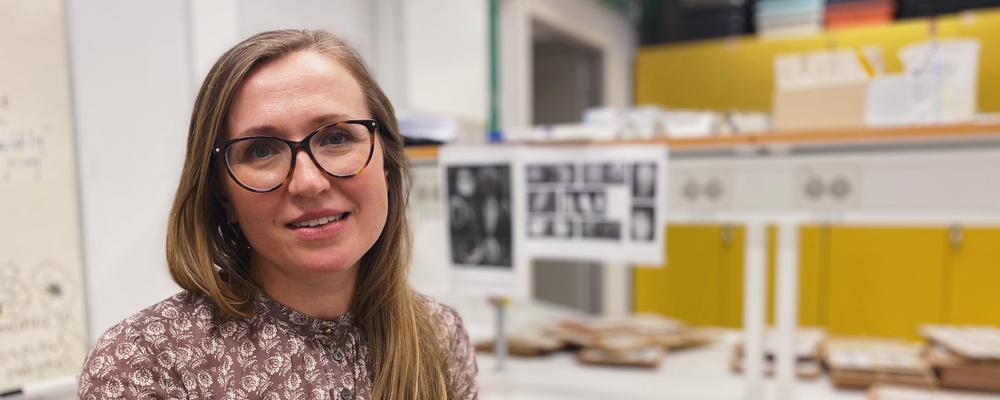
- Home
- Research
- Find research
- Irina Polovodova Asteman uncovers the marvels in the seafloor
Irina Polovodova Asteman uncovers the marvels in the seafloor
Marine geologist Irina Polovodova Asteman studies the microscopically small that is concealed in the seafloor.
From long cores of mud, she uncovers the most astonishing organisms that can convey details about both the climate, as well as the environment.
“The sediment is like a time machine. When we study the seafloor, we can actually travel back in time.”
Irina Polovodova Asteman is a marine geologist. Marine geologists work in the same way as archaeologists: they search for buried traces of life.
But when archaeologists work on land with brushes, scrapes and sieves to unveil human objects in dry soil, Irina Polovodova Asteman goes out to the sea and picks up long cores filled with mud from the seafloor, which she first processes, and then studies under a microscope.
“It’s so incredibly exciting when I start to look in the microscope, because I never know what to expect, or what kind of knowledge I will be able to obtain by studying the sediment archives. The fossilised remains of tiny plants and animals we find in the ocean mud, can reveal so many things: how the climate has varied over time; if there has been deoxygenation or eutrophication; how pelagic or bottom-dwelling communities have changed over time; and even when invasive, or non-indigenous species first have arrived to our coastal waters,” says Irina Polovodova Asteman.
Foraminifers tell about the climate and the environment
One of Irina Polovodova Asteman's main research interests are the small, single-celled amoeboid protists called foraminifera. The foraminifera are known as “armoured amoebas” due to the presence of external shells made of either calcium carbonate, or built from sediment particles glued together on an organic matrix. Most foraminifera are smaller than a grain of sand (63 micrometres), and in appearance they resemble beautiful snails, or tiny monsters.
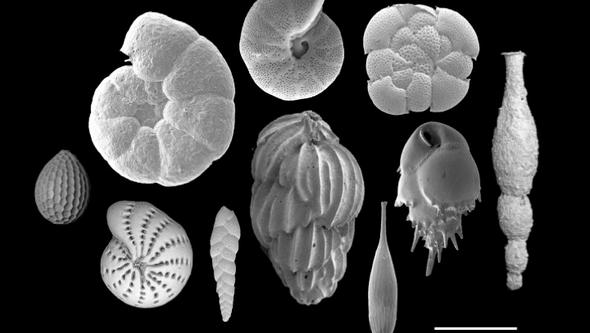
Foraminifera evolved in the oceans approximately 540 million years ago, so they have been around for quite some time, and they can reveal many things about the ocean’s history in relation to the climate and the environment, from deep time to the present. The chemical composition of foraminiferal shells can reveal changes in the ocean related to, for example: climate, deoxygenation, acidification, and human-induced pollution.
Some species of foraminifera are opportunistic, and are able to thrive in oxygen-depleted environments. These species can breathe nitrogen in the form of nitrate, and can thus help to counteract eutrophication. So, when there is a lack of oxygen, and other large taxa such as snails, bivalves or crustaceans disappear, the foraminifera will still bloom – something that shows that they are important to their environment.
“This is why foraminifera are so extraordinary: they are super-tiny; they only have one single cell divided into small organelles; but they have an important function in the ecosystem, for example through participating in the biogeochemical cycles and by being part of the food chain. Evolution has also given them both the ability to breathe nitrogen, and the ability to form amazingly beautiful and incredibly complex shells. I’m in awe every time I look at my samples: all these beautiful treasures are concealed in the seafloor, buried in the mud and the guck!”
The sediment is always a mystery
The fact that the sediment is always a beautiful mystery is one of the reasons why Irina Polovodova Asteman became a marine geologist in the first place. She was born near the small Russian town of Magadan, by the Sea of Okhotsk, and moved to St. Petersburg to study geography and environmental studies to become a geographer. But just before she was to specialise in botanical geography, she thought: “No, I do not want to look at flower petals under a microscope for the rest of my life!”
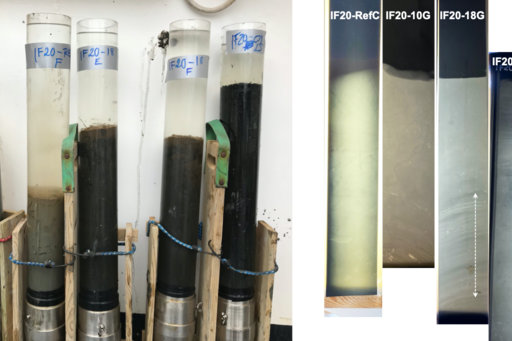
Instead, Irina went for a study-exchange to the Christian-Albrechts University in Kiel, Germany. For the first time, she got the opportunity to examine sediment samples from the Arabian Sea, and it was then she discovered how beautiful the sediment could be. After that, she was forever stuck in the world of sand and mud – which is why she later returned to Kiel to pursue a PhD in marine geology and palaeontology.
“If you look at a flower petal under a microscope, you roughly know what to expect. But as a marine geologist, I never know what I’ll uncover in the microscope before I start. The sediment is always a mystery, a voyage into the unknown!”
“So even though I told myself I did not want to look in a microscope for the rest of my life, I do it anyway!”, she laughs.
Discovered new species in Gullmarsfjorden
Irina Polovodova Asteman has for many years worked with the eight-meter-long core that was retrieved in 1990 from Gullmarsfjorden, which goes back approximately 2500 years. She also takes samples from the most surficial sediment in the fjord to compare the modern faunas with the fossil ones to detect changes.
“One of the biggest advantages of working at the University of Gothenburg is that we have the research vessel Skagerak. That means that I can go out and take samples along the Bohus coast when I need it,” says Irina Polovodova Asteman.
One of Irina Polovodova Asteman's biggest achievements as a researcher was when she discovered a new species of foraminifera in Gullmarsfjorden in 2013.
“I hadn’t seen anything like it in Gullmarsfjorden in 2000 years, so it was a very important discovery,” says Irina Polovodova Asteman.
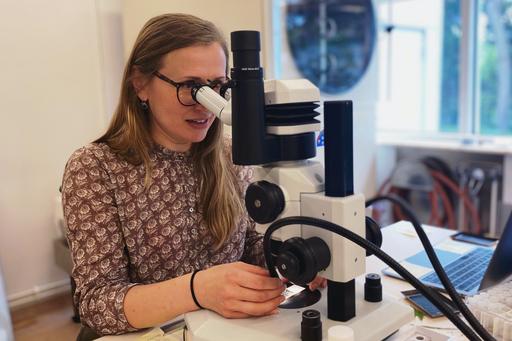
At first, Irina thought it might be the Nonionella stella species from the Santa Barbara Basin off the coast of California that had arrived in Gullmarsfjorden with ballast water. In order to check this, Irina sent some live specimens of the new species to Scotland for DNA sequencing. But when the answer came, it was unexpected because it was not Nonionella stella, but another species that is still unidentified.
“This is because we still lack DNA codes for many species in the family, so the database is not complete. Therefore, we are cautious in giving the newcomer a name, so the species has so far only been given a genotype name: Nonionella sp. T1.”
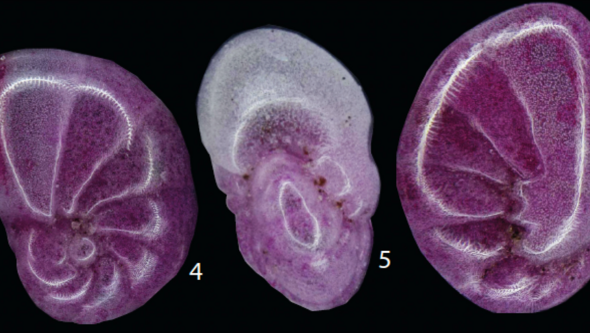
“But we know that Nonionella sp. T1 is new and alien in Gullmarsfjorden; that it breathes nitrogen even if oxygen is available; that it is highly abundant there; and that it thrives. But what we still do not know is what will happen to the seafloor ecosystem in Gullmarsfjorden if Nonionella sp. T1 takes over and becomes dominant. We want to study this in the future.”
Biodiversity must also include the miniscule
Irina Polovodova Asteman is breaking new ground with her research in several ways. ‘Foraminifera have for a long time been studied mostly by geologists, which means that the major focus of research was on their fossil shells’. Irina Polovodova Asteman also studies living foraminifera and their ecology – something researchers for a long time have had very little knowledge about, since these tiny critters are difficult to grow in laboratories.
“The first paper that foraminifera could breathe nitrogen came in 2006. That’s not very long ago!”

Irina also studies coastal areas instead of the deep sea, and looks at species smaller than a sand grain – species that Irina thinks deserve more attention.
“How can we talk about biodiversity, or invasive species for that matter, if we don’t include the smaller species? We know that foraminifera are important because they thrive in places with deficiency of oxygen. To me, it’s incomprehensible that we don’t include them,” says Irina Polovodova Asteman.
Coast as home for future generations
One third of the earth's population lives in coastal areas. Therefore, Irina never gets tired of studying these miniscule organisms that can be found in the coastal sediment. More and more research show that the tiny foraminifera also are important for biomonitoring and ecological quality status assessment, since the shells remain as fossils in the sediment, whereas larger animals, such as starfish, mussels, and worms, usually are not preserved over time.
Therefore, foraminifera are valuable assets in, for example, geographical regions with a long history of pollution, as they allow researchers to study long-term changes in the environment from preindustrial times, through a major discharge period and towards the recovery from pollution.
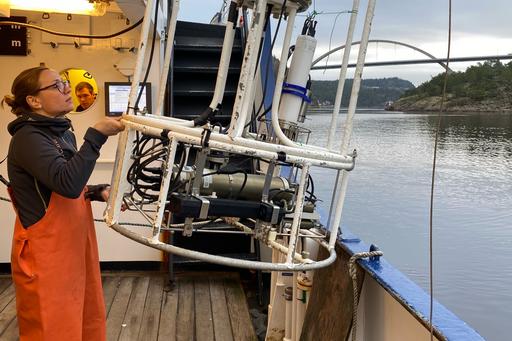
“I often think about what we leave behind for future generations. Changes in the deep sea currents, and global environmental issues, are of course important, but I would like to stay focused on studying coastal waters because this is where we live. We build our knowledge about future climate and future living environment based on the information we get from the past, and marine sediments can help here a great deal.”
Translation from Swedish: Annika Wall & Irina Polovodova Asteman
Title
Senior Lecturer
Born
Magadan, Russia (former Soviet Union) in 1980
Education
BSc and MSc in St. Petersburg, PhD in Kiel, Germany 2008)
Work
Came to the University of Gothenburg and the Department of Earth Sciences as postdoc in 2009, stayed as teacher and researcher until 2014. Worked as a researcher at Bjerknes Center for Climate Research in Bergen, Norway, and as a geologist at Marine Map Tech (MMT) between 2014 and 2019. From 2019, Senior Lecturer in Marine Geology at the Department of Marine Sciences.
Favorite species
Hard to say, they are so many! But right now, perhaps it is the newcomer Nonionella sp. T1.

